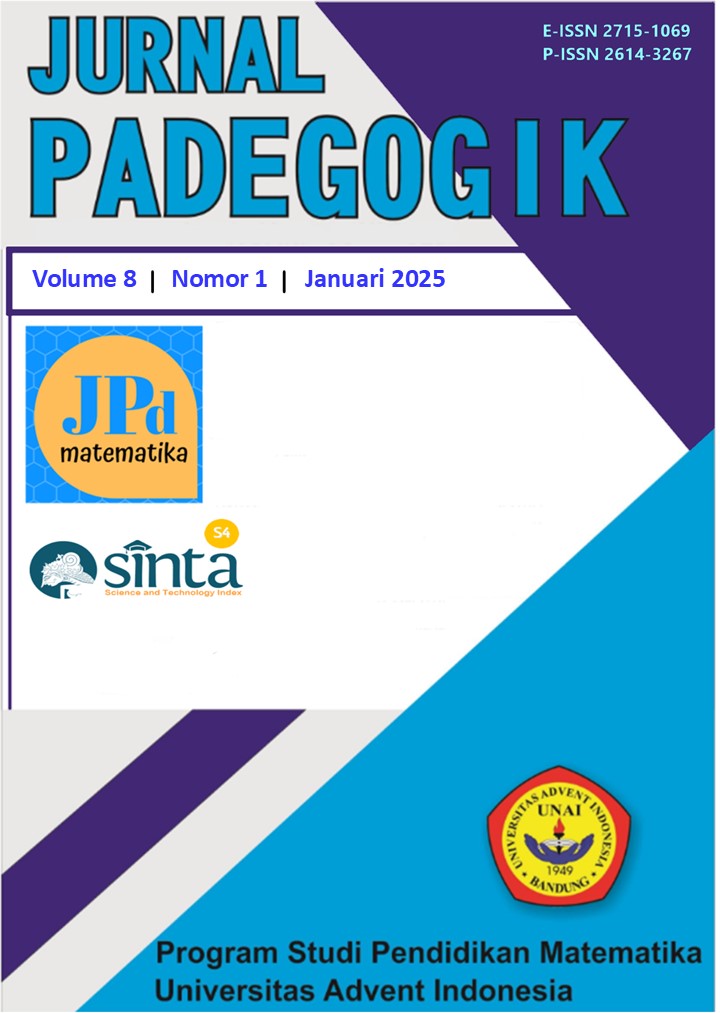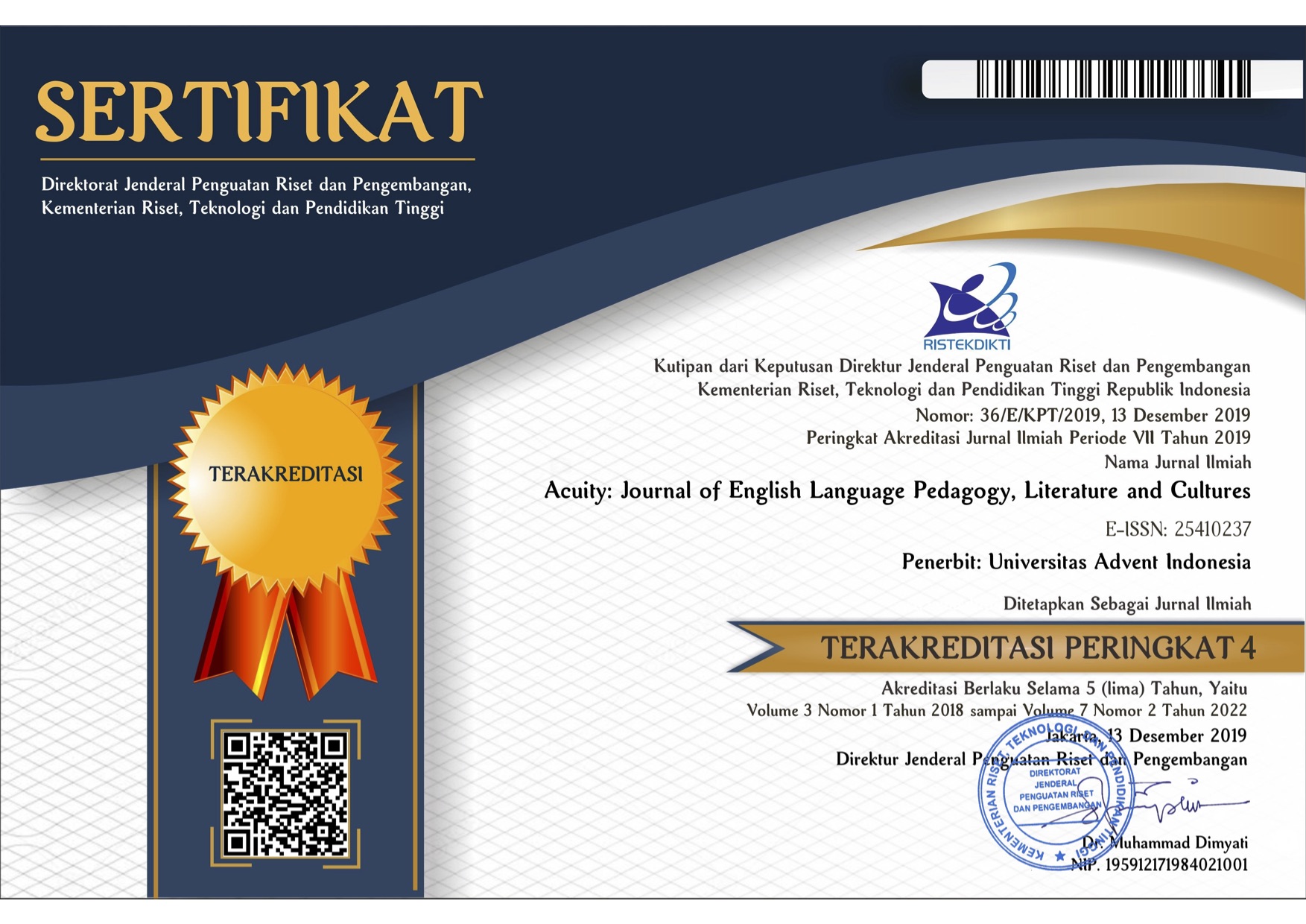PENGGUNAAN MATHEMATICAL LEARNING-OBJECT BERBASIS BLENDED PICTORIAL ABSTRACK TERHADAP KEMAMPUAN REFLECTIVE ABSTRACTION MAHASISWA
-
Keywords:
Mathematical Learning Object, Blended-Pictorial abstract, Reflective Abstraction AbilityAbstract
This research aims to determine the use of Mathematical Learning Objects based on blended pictorial abstracts on the Reflective Abstraction abilities of students in the mathematics selection category. The subjects in this study were 107 students of the Mathematics Education Study Program who contracted secondary school mathematics courses (or equivalent) from four private universities on the island of Java. The subjects were taken purposively, the selection of universities was carried out randomly. The results obtained are: (1) There are differences in the Reflective Abstraction abilities of students who learn using Mathematical Learning Objects based on blended Pictorial abstract based on the prerequisite knowledge ability (KPP) categories of low, medium, high, with sig.0.006; (2) Based on further tests, to see which one is better, the results obtained are sig. 0.008 for KRA_KPPR and KR A-KPPS; sig. 0.002 for KRA_KPPR and KRA-KPPST; and sig. 0.500 for KRA_KPPS and KRA- KPPT. This means that: the Reflective abstraction ability of students in the medium KPP category is better than the students in the low KPP category, the Reflective abstraction ability of students in the high KPP category is better than the students in the low KPP category, the Reflective abstraction ability of students in the high KPP category is no better than the students in the medium KPP category.
Downloads
References
Abdulhak,I dan Darmawan, D. 2017. Teknologi Pendidikan. Bandung: PT Remaja Rosdakarya.
Anam, Ahmad Choirul (2021). Abstraksi Reflektif Siswa Sekolah Menengah Menengah Pertama pada Materi Segiempat dan Segitiga. Jurnal Pendidikan dan Pembelajaran Matematika Alifmatika. e-ISSN: 2715- 6109. [online] tersedia: https://journal.ibrahimy.ac.id/index.php/Alifmatika.
Astuti, E. P. (2017). Representasi matematis mahasiswa calon guru dalam menyelesaikan masalah matematika. Beta Jurnal Tadris Matematika, 10(1), 70. https://doi.org/10.20414/betajtm.v10i1.100.
Azis YM, Juanda EA. 2016. Komposisi Waktu Pembelajaran dalam Blended Learning. Prosiding SENTIA – Politeknik Negeri Malang. Volume 8 – ISSN: 2085-2347. [Online, tersedia:…]
Darmawan, Deni (2016). Pengembangan E-Learning Teori dan Desain. Bandung: Remaja Rosdakarya.
Dubinsky (1991). Reflective Abstraction in Advanced Mathematical Thinking. [online] tersedia: https://people.math.wisc.edu/~wilson/Courses/Math903/ReflectiveAbstra ction.pdf.
Faizah. DN (2016). Analisis kemampuan Abstraksi Matematis Siswa SMA Kelas X Ditinjau ddari Gaya Belajar. Skripsi: UNIVERSITAS MUHAMMADIYAH PURWOKERTO. [online] tersedia: http://repository.ump.ac.id
Ferdinand Krauss Mohamed Ally. (2006). A Study of the Design and Evaluation of a Learning Object and Implications for Conten Development Interdisciplinary. Journal of Knowledge and Learning Objects.
Hafizah. 2015. Peningkatan Kemampuan Penalaran Matematis, Komunikasi Matematis, dan Kemandirian Belajar Mahasiswa Calon Guru Matematika Melalui Blended Learning dengan Strategi Probing-Prompting. Disertasi UPI: Tidak diterbitkan.
Hasbullah. (2006). Implementasi e –Learning dalam Pengembangan Pembelajaran di Perguruan Tinggi (Proceeding), SNPTE 2006,UNY. Yogyakarta. [online] tersedia:http://staffnew.uny.ac.id
………… 2014. Blended Learning, Trend Strategi Pembelajaran Matematika Masa Depan. Jurnal Formatif : 65-70. ISSN: 2088-351X. [Online, tersedia:…]
Ian Gilhespy. (2008). Issues in the Development of an Inclusive Curriculum: Listening to Student Voices in the Evaluation of Reusable Learning Objects in the Subject Areas of Sport, Leisure and Outdoor Adventure. Journal of Hospitality, Leisure, Sport and Tourism Education.Vol 8 No. 2. [online] tersedia.
Iliana, et al (2021). Effectiveness of the use of a learning object in students of the programming area in higher education Eficacia del uso de un objeto de aprendizaje en estudiantes del área de programación en el nivel de educación superior. Journal Computer Technology. Vol.5 No.15 1-12. [online] tersedia: https://www.ecorfan.org/spain/researchjournals/Tecnologia_Informatica/ vol5num15/Journal_Computer_Technology_V5_N15_1.pdf
Istiqomah SBT, Azizah N. 2013. Penerapan Metode Blended Learning Berbasis ICT untuk Meningkatkan Minat dan Prestasi Belajar pada Mata Kuliah Ilmu Sosial Budaya Dasar (ISBD) Di Prodi D-III Kebidanan FIK Unipdu Jombang. Jurnal Eduhealth, VOL. 3 NO. 2. [Online, tersedia:…]
Jana, Eri Haeril dan Tri Ginanjar Laksana. (2012). Aplikasi E-Learning Berbasis Web untuk Meningkatkan Motivasi Pembelajaran (Studi Kasus: SMA Negeri 1 Talaga Kab. Cirebon). Jurnal Online ICT STMIK IKMI Vol. 1 No. 2 Edisi Desember 2012.
Joyce, B & Weil, M. 1992. Models of Teaching. Fourth Edition. London: Allyn and Bacon. Lestari. KE, Yudhanegara MR. 2015. Penelitian Pendidikan Matemtika. Bandung: PT Refika Aditama.
Mardiyah,U dan Budiarto, M. (2019). Abstraksi Reflektif dalam Mengkontruk bangun Segiempat. Jurnal Ilmiah Pendidikan Matematika MATHEdunesa Volume 8 No. 2 Tahun 2019 ISSN :2301-9085 517. [online] tersedia: https://ejournal.unesa.ac.id.
Maulani. F, dkk (2020). PENERAPAN PENDEKATAN CONCRETE- PICTORIAL-ABSTRACTTERHADAP KEMAMPUAN PEMAHAMAN KONSEP MATEMATIS PADA MATA PELAJARAN MATEMATIKA KELAS V SD. Jurnal ABSIS. Vol 2 No 2. [online] tersedia
Muin, A. 2016. Peningkatan Kemampuan dan Disposisi Berpikir Reflektif Matematis Mahasiswa dengan Pendekatan Metakognitif. Bandung: Disertasi UPI: Tidak diterbitkan.
Nur aeni, dkk. 2017. Pengembangan Model Blended Learning Berbasis Masalah pada Mata Pelajaran Sistem Komputer. IJCET Innovative Journal of Curriculum and Educational Technology [Online, tersedia: https://journal.unnes.ac.id/sju/index.php/ujet. 15/04/2018].
Nurlaelah, E. (tanpa tahun). Abstraksi Reflektif Dalam Berfikir Matematika Tingkat Tinggi. [Online: Tersedia]
Palupi, P., A. & Gunawan, I., Taksonomi Bloom – Revisi Ranah Kognitif : Kerangka Landasan Untuk Pembelajaran pengajaran, dan penilaian, (Journal Premiere Educandum : Pendidikan Dasar dan Pembelajaran, Vol. 2, No. 2, 2012)
Permadi, Hendro (2015) Metoda Statistika Praktis. Common Textbook. Malang: Universitas Negeri Malang.
Plomp, Tj. 1997. Educational Design: Introduction. From Tjeerd Plomp (eds). Educational & Training System Design: Introduction. Design of Education and Training (in Dutch).Utrecht (the Netherlands): Lemma. Netherland.Faculty of Educational Science and Technology, University of Twente.
Putri,HE. 2015. Pengaruh Pendekatan Concrete-Pictorial-Abstract (CPA) Terhadap Peningkatan Kemampuan Representasi Matematis, Spatial Sense, dan Self-efficacy Mahasiswa Calon Guru Sekolah Dasar. Disertasi UPI: Tidak diterbitkan.
Ruseffendi, E.T., (1991). Pengantar Kepada membantu Guru Mengembangkan kompetrensinya dalam Pendidikan Matematika untuk Meningkatkan CBSA. Bandung : Tarsito.
………………. (1992). Statistika Dasar untuk Penelitian Pendidikan. Departemen Pendidikan dan kebudayaan: direktorat Jenderal Pendidikan Tinggi.
…………………. (1998). Dasar-Dasar Penelitian Pendidikan Dan Bidang Non-Eksakta Lainnya. Semarang : IKIP Semarang Press.
Rusman, dkk. 2015. Pembelajaran Berbasis Teknologi Informasi dan Komunikasi. Jakarta: PT Prajagrafindo Persada.
Sabandar, J. (2007). Berfikir Reflektif. Makalah pada seminar Nasional Matematika 2007. Bandung; Tidak dipublikasikan.
Sudjana (2005). Metoda Statistika. Bandung: Tarsito.
Soedjadi, R. (2000). Kiat Pendidikan Matematika di indonesia. Jakarta : Dikti
Sugiyono (2014). Statistika untuk Penelitian. Bandung: Alfabeta.
………... (2014). Metode Penelitian Kombinasi (Mixed Methods). Bandung: Alfabeta.
………… (2015). Metode Penelitian Pendidikan Pendekatan Kuantitatif, Kualitatid, dan R&D. Bandung: Alfabeta.
Downloads
Published
How to Cite
Issue
Section
License
Copyright (c) 2025 Jurnal Padegogik

This work is licensed under a Creative Commons Attribution-NonCommercial-ShareAlike 4.0 International License.
The submitting author warrants that
- The submission is original and that she/he is the author of the submission together with the named co-authors; to the extend the submission incorporates text passages, figures, data, or other material from the work of others, the submitting author has obtained any necessary permission.
- Articles in this journal are published under the Creative Commons Share-Alike Attribution Licence (CC-BY-SA What does this mean?). This is to get more legal certainty about what readers can do with published articles, and thus a wider dissemination and archiving, which in turn makes publishing with this journal more valuable for you, the authors.
- By submitting an article the author grants to this journal the non-exclusive right to publish it. The author retains the copyright and the publishing rights for his article without any restrictions.








